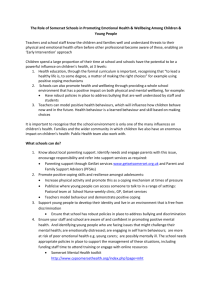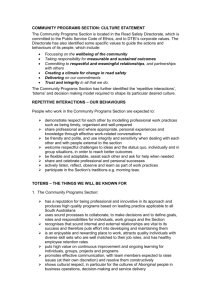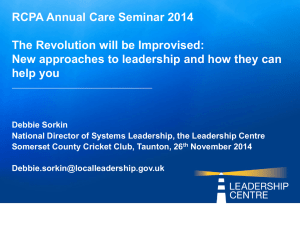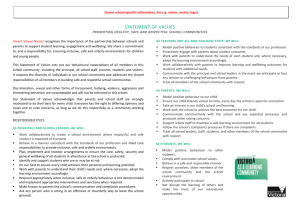ObservationalEvaluation_Sep14
advertisement
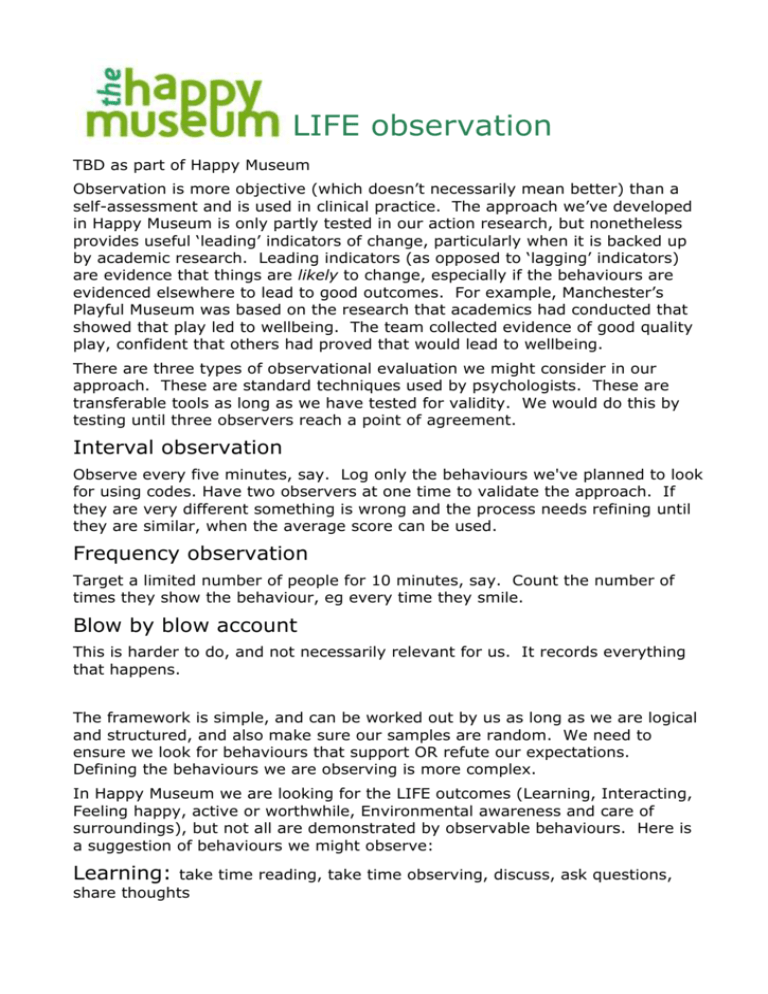
LIFE observation TBD as part of Happy Museum Observation is more objective (which doesn’t necessarily mean better) than a self-assessment and is used in clinical practice. The approach we’ve developed in Happy Museum is only partly tested in our action research, but nonetheless provides useful ‘leading’ indicators of change, particularly when it is backed up by academic research. Leading indicators (as opposed to ‘lagging’ indicators) are evidence that things are likely to change, especially if the behaviours are evidenced elsewhere to lead to good outcomes. For example, Manchester’s Playful Museum was based on the research that academics had conducted that showed that play led to wellbeing. The team collected evidence of good quality play, confident that others had proved that would lead to wellbeing. There are three types of observational evaluation we might consider in our approach. These are standard techniques used by psychologists. These are transferable tools as long as we have tested for validity. We would do this by testing until three observers reach a point of agreement. Interval observation Observe every five minutes, say. Log only the behaviours we've planned to look for using codes. Have two observers at one time to validate the approach. If they are very different something is wrong and the process needs refining until they are similar, when the average score can be used. Frequency observation Target a limited number of people for 10 minutes, say. Count the number of times they show the behaviour, eg every time they smile. Blow by blow account This is harder to do, and not necessarily relevant for us. It records everything that happens. The framework is simple, and can be worked out by us as long as we are logical and structured, and also make sure our samples are random. We need to ensure we look for behaviours that support OR refute our expectations. Defining the behaviours we are observing is more complex. In Happy Museum we are looking for the LIFE outcomes (Learning, Interacting, Feeling happy, active or worthwhile, Environmental awareness and care of surroundings), but not all are demonstrated by observable behaviours. Here is a suggestion of behaviours we might observe: Learning: take time reading, take time observing, discuss, ask questions, share thoughts Interacting: smile at someone, talk, touch, offer help Feelings: smile, laugh, play, cry, appreciate aesthetics, express yourself Environmental awareness and care of surroundings: making a donation, recycling leaflets Learning and interacting are behaviours evidenced in the Five Ways to Wellbeing and the third and fourth are important particularly for Happy Museums. To be able to evidence these in a busy gallery environment we need to easily record them using our coding LIFE and perhaps an additional code of 1,2, or 3 for the intensity of the behaviour. It might be too complex to observe for four at the same time, so we need to take them sequentially and use either frequency or interval observation. These observations will provide indicators that wellbeing is being promoted. The second stage might be to also look for evidence of what it is that is creating the wellbeing, which exhibits for example, or whether people are visiting in groups or individually. For example Manchester Museum looked at types of behaviour and observation of who was involved in these responses. Where there was an adult involved the creative response was biggest (15 occurrences). Where there were multiple children together fun and imagination predominated (12 and 11) and where there was a single child, imagination was most frequently demonstrated (9). This presents some interesting ideas for ways to generate outcomes, or to respond to different groups of visitors. Observation One little girl picked up the smallest spider and carried it around before placing it carefully on the floor. Another child shouted ‘don’t wake the spider!’ A group of children started jumping on the bubble wrap shouting ‘is it real?’ One parent said to his children ‘don’t wake the spider’ so they tiptoed towards it had a look and then carefully walked away. Several children walked into the area with parents and tip toe over the bubble wrap to see the display cases- it appeared they thought they shouldn’t walk over it. Emotion excited quiet fun negative enthusiastic creative imaginative imaginative Count emotion Group 9 adult involved 3 mixed 25 multiple children 0 single child 1 teenagers 28 30 single child excited imaginative multiple children multiple children quiet adult involved VSA observation mixed Other tools eg Dementia Care Mapping By way of example of how these tools can be used, Dementia Care Mapping is an observational tool used by care practitioners, researchers and service providers to evaluate the quality of life and quality of care of people with dementia. As with individual assessments, it is sometimes useful to use the tools of partners. The observations recorded by the Mapper capture levels of behaviour and well-being in order to gain an understanding of the experience of care from the perspective of the person with dementia. During a Dementia Care Mapping, every five minutes the Mapper will record a Behaviour Category Code (BCC) which represents what each person was mainly doing for that period of time. This is chosen from a list of 23 codes which are denoted by a letter for example, F= eating and drinking, E= expressive or creative activity, N= nod, land of! In each time frame the Mapper also records a Mood and Engagement (ME) Value, which represents how engaged the person is and whether their mood is positive or negative. This is represented on a 6 point scale (+5, +3, +1, -1, -3, -5).


